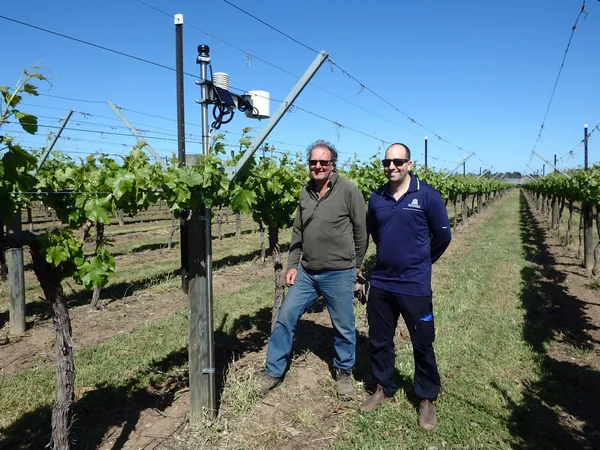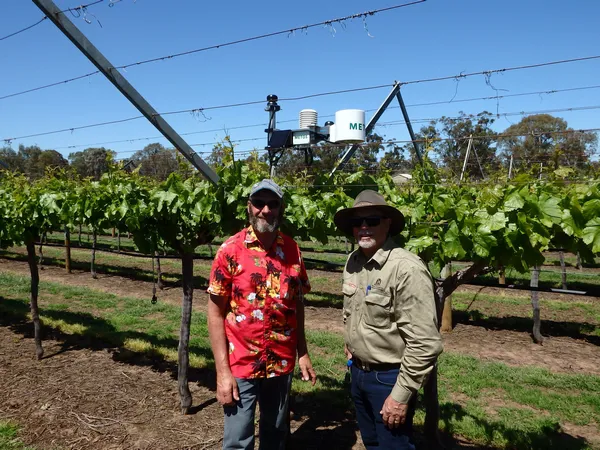High-tech weather stations are being installed on four table grape properties across Western Australia's Swan Valley, South West and Gascoyne, as part of a new project to evaluate the accuracy of commercial disease risk prediction tools.
There has been a proliferation of decision support applications in recent years to improve fungicide use efficiencies by refining the timing of treatments to optimise effectiveness and reduce control costs. This research project will examine the development of the fungal disease, powdery mildew, under local weather conditions and compare the data to that used by commercial prediction models.
WA's Department of Primary Industries and Regional Development (DPIRD) plant pathologist Dr Andrew Taylor said while there was interest among local growers in the use of commercial models to help predict the risk and severity of the disease, it was important to confirm their effectiveness under local conditions.
“Many of these tools have been developed according to the growth rate and lifecycle of the disease in major table grape growing regions in Europe and California,” Dr Taylor said. "This project seeks to understand if the decision support tools accurately predict powdery mildew infection according to the same weather data parameters as the international applications, under Western Australia’s climatic conditions and trellis production systems.”

Photo: Table grape grower Philip Yukich (left) and DPIRD research scientist Dr Andrew Taylor next to one of the new weather stations in the Swan Valley (©2020 DPIRD)
According to DPIRD, powdery mildew is the biggest disease threat to Australian grape production, costing the national industry $76 million per annum in lost production and control measures. A number of parameters are being measured, including relative humidity and temperature above and within the vine canopy, as well as wind speed and direction and leaf wetness every 15 minutes.
Dr Taylor said the data from the devices could be accessed in real-time via a smartphone app, which would assist researchers, growers and consultants to make more informed and timely management decisions.
“The numerous weather parameters on these weather stations enable us to monitor the micro climate-within the fruit zone of the canopy and determine what influence that has on the powdery mildew infection,” he said. “The data can also be used by growers to assist issues outside of disease management, including crop physiology and water use efficiency. Some trends may also emerge from the data, which may be useful for growers to refine their disease management regimes.”
Powdery mildew is caused by the fungal pathogen Erysiphe necator, which occurs as ash grey-white powdery growth on leaves and berries, which can impair grape flavour, cause berry splitting and can reduce vine vigour and productivity.

Photo: Grower Brian Stanicich (left) and DPIRD senior technical officer Colin Gordon with a weather station being used to evaluate commercial digital disease risk prediction tools. (©2020 DPIRD)
Growers manage powdery mildew as part of an Integrated Disease Management plan, which includes good canopy management practices and fungicide treatments. Overseas evidence has shown the use of digital tools can reduce fungicide treatments by two sprays per season, representing a significant cut in control costs.
“This project is an example of the progressive nature of the WA table grape industry and adopting technology to assist them in their on-farm decision making,” Dr Taylor said. “Rather than ‘reinvent the wheel’, this project will give growers confidence in the use of existing tools and their suitability for use in WA. It also gives us the opportunity to evaluate the effectiveness of powdery mildew control measures in WA and identify if there are any opportunities to tweak treatment strategies to improve efficiencies and reduce the risk of fungicide resistance.”
The DPIRD is leading the three-year project, with support from the Agricultural Produce Commission (APC) table grape producers committee. The weather stations have been installed on commercial table grape properties in the Swan Valley, Hamel and Carnarvon.
For more information: https://www.agric.wa.gov.au/table-grapes/powdery-mildew-grapevines-western-australia
Expansion of SA's Mesonet weather network to benefit farmers
Primary producers in South Australia's Mid North, Mallee and Riverland are set to benefit from the $1.4 million Mesonet weather network installation with 30 weather stations to be installed by the end of 2020.
Funded under the Government's Regional Growth Fund, the system allows producers through their mobile phones and computers, to access more applicable, up to date weather information, and in particular identify weather inversions near their properties. Minister for Primary Industries and Regional Development David Basham said the expansion of the $1.4 million localised weather system will give primary producers greater data to make an informed decision.
"By the end of this year, we anticipate 30 weather stations will be installed across the Mallee and Riverland with the majority to be operational by the commencement of the fire season. This will be in addition to 40 stations that came online across the Mid North in 2019," Minister Basham said. "Not only will the expanded system assist primary producers during the upcoming fire season but will also be invaluable, particularly to farmers, as they plan spring and summer spraying operations. With this information, farmers can avoid spraying when weather conditions indicate spray drift is likely."
In addition to the new stations, two research stations with 3D wind sensors are also planned for Loxton and Geranium. With recent wet weather over spring, producers are also being reminded about the need to consider good diligence when planning their spraying operations.
Mr Basham added that while the Mesonet system is an extremely valuable tool, growers will still need to measure, assess and record the weather at the sites they are proposing to spray.
"Estimates currently put the potential loss of value of agricultural production in the Mid North, Riverland and Murraylands from spray drift at over $430 million per annum, so it is important we continue to educate and put management tools in place to address this issue.
The government is also warning of the importance of being aware of sensitive crops, particularly newly shooting grapevines which are highly susceptible to many broad-acre herbicides.
For the latest Mesonet data visit: www.midnorthmesonet.taindata.com
